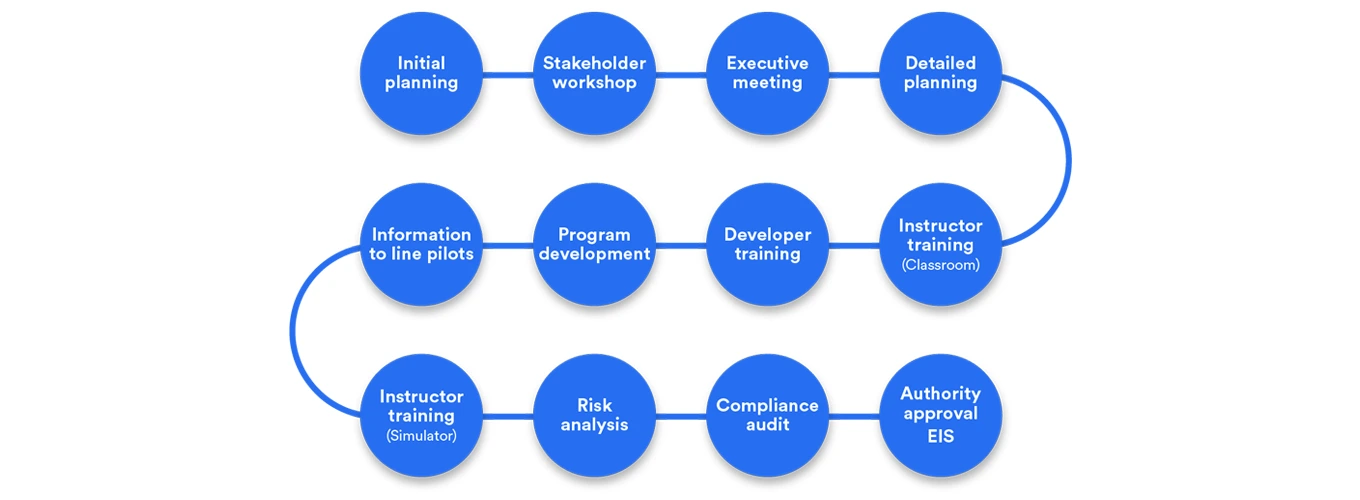Having been involved now in many EBT projects we can now say with some confidence what makes a successful journey into the program. So, if you are considering EBT how long does it take and what resources do you need?
The first step is usually to consider what is called a Mixed Implementation. Put simply, we continue to comply with the regulatory training and checking requirements by changing the ICAO Maneuvers Training phase into a Maneuvers Validation or Check. The Mixed Implementation was considered when we wrote ICAO Doc 9995, Chapter 4, 4.2 b) and was endorsed through a process of rulemaking by EASA for European operators in 2015.
Engagement
To maximize the benefits of EBT, we need to engage with internal and external stakeholders. We suggest gathering leadership from training, operations, safety, compliance, and the authority to develop an understanding of the program and its objectives and to understand how this may result in an adjustment of internal practices.
Planning
The implementation timeline is usually determined by the rate that instructors can be released in groups to receive training. Instructor training is usually the main cost of implementation based on the internal cost of non-productive days in the classroom.
Instructor Training
We have trained over 1,500 instructors in our 3-day classroom course and we believe it’s about the right amount of time to give instructors a foundation. There is more to do in reinforcing their skills, especially working with a completely new approach to the assessment of performance and the key skill of facilitation. We strongly recommend a coaching program at least for a group of standardization instructors and run real time simulator coaching exercises where classroom learning can be applied.
Documentation
Revisions to Operations Manuals are required to support the Mixed Implementation, in a number of areas and it’s always a good idea to start this process early, with new information to support EBT and the removal of incompatible processes and instructions. There will be a new 3-year program, a malfunction equivalency process with results, the competency framework supported by a new grading system, and the description of instructor training to support the change. Over time any CRM training will need to be adjusted to fit the competency framework.
Pilots
Pilots will initially be apprehensive about the changes to EBT. Communication to them as a group may take many forms using meetings, ground training, newsletters, internal networks and presentations. The best communication always usually comes from the word of mouth, and instructors are the leaders here. After training we hope they become ambassadors for the program and can allay any fears and reduce the apprehension of pilots to the new training system. Communication should start early to prevent rumor and speculation. Transparency is everything in achieving buy-in for the change.
Program Development
Developing the program requires some new tools and skills. In a Mixed Implementation the regulatory checks are usually completed in less than 2 hours. so in a typical EBT module of 8 hrs., we have more than 6 hours in which to build something new. This presents a challenge to developers who have been constrained by prescriptive regulation. Taking the shackles off and starting out at the new green field is exciting but also challenging. We often start with a malfunction equivalency analysis based on FSTDs that will be used. For the program itself we strongly recommend a small team approach to development with the facility for testing in the simulator before release. We provide dedicated training for the developers and follow the development process to make sure the program meets expectations for the Entry Into Service.
Final Steps
After this all that remains is a compliance audit of the training program and the completion of an implementation risk analysis. Both of these steps are important in order to present the program to your authority for approval. Although compliance is assured by following the steps, the program will look quite different and needs explanation and referencing to existing regulation. The implementation risk analysis is really about quantifying steps taken to mitigate the risks of poor implementation, such as instructors who lack tools and understanding for what is a significant change.
Analysis of safety data
Although EBT can be seen as an off the shelf program and there is no immediate need for complex safety data analysis to support the program, it is a good idea to begin a conversation with safety teams so that their practices may also be adjusted to provide good information to support training development. For this we provide dedicated training for safety analysts and managers. Competency based training presents what can be a common language for looking at human performance in any safety critical roles within the organization. It also provides for a common language for the analyses of safety reports and the conduct of any investigations.
By now we should be ready to finalize a submission including compliance audit and implementation risk analysis.
The process is straightforward and the key to success is having a dedicated and well-informed project manager, at least until EBT becomes Business as usual. The other element that drives success is the communication and engagement of everyone affected by and involved in the program. We wish you success in your journey and you know where to find us.




